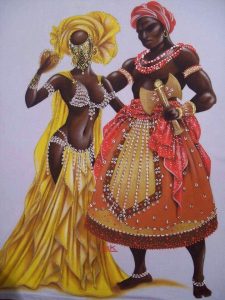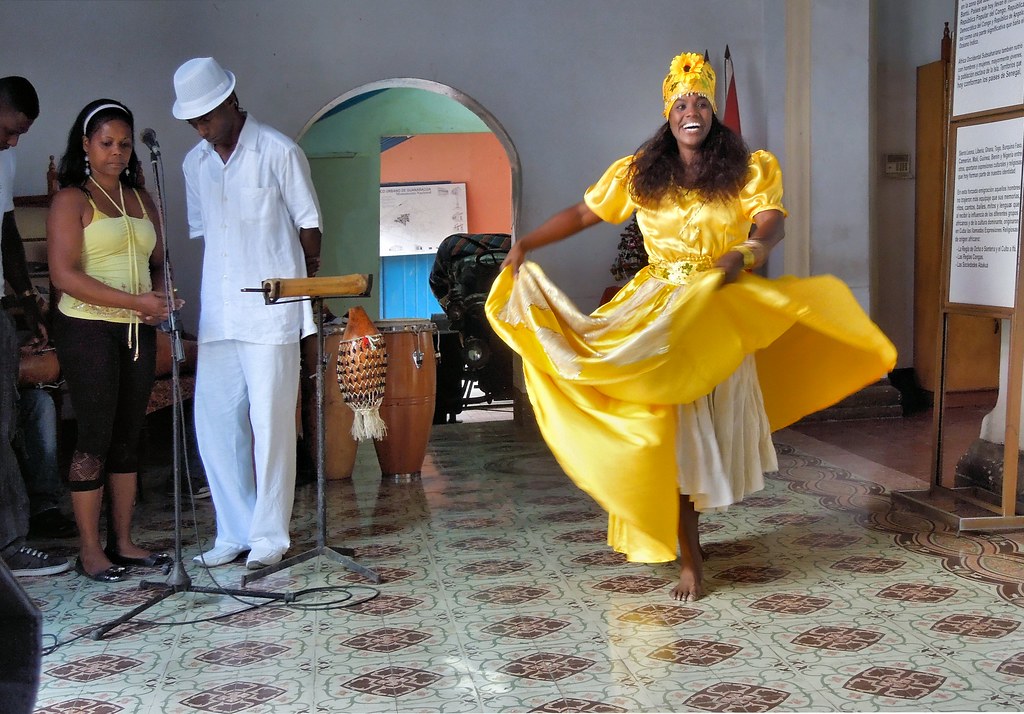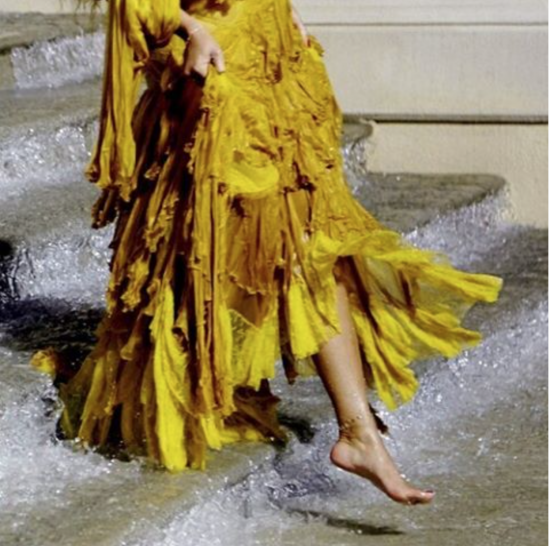Beyonce’s visual album Lemonade is a smorgasbord of decadent imagery flush with stunning cultural references, from a gloriously terpsichorean Serena Williams to the Egyptian queen Nefertiti. But as a seduction devotee, the evocation of Oshun emerges as one of the film’s most beautiful, “teachable” moments. Oshun, an archetypal symbol for the feminine principle, serves as a meaningful guide. Through her patakis, or stories, she reveals the secret power of women, and teaches us all the (lost) art of love.

In one of Lemonade’s now most iconic scenes, songstress (diva archetype) Beyonce Knowles emerges between double doors clad in a magnificent yellow dress. In one ecstatic moment, a torrent of water engulfs her and cascades down a flight of stairs as the barefoot beauty saunters in its wake. Sheathed in the orisha’s signature yellow and gold, water jettisoning about, Beyonce masterfully channels Oshun, the Yoruba deity of sweet waters, sensuality, creativity and abundance.
In the West African Yoruba spiritual tradition, orishas are intermediaries between humans and the creator. Like her love goddess counterparts, among them Venus, Aphrodite, and Astarte, Oshun is a divine reflection of mankind’s deep reverence for femininity in its highest expression; intelligence and intuition, emotional depth, unbridled eroticism, and the capacity for physical and psychic manifestation. Together, these qualities make up the feminine principle.
The feminine principal, also referred to as the sacred feminine, feminine mystique, sacral energy, shakti, or even yin, refers to the creative force from which all life emerges. This mysterious, feminine force is so awe-inspiring and inchoate, that in every culture, we find a love goddess who personifies it– Venus, Aphrodite, Innana, Astarte, Hathor, Mami Wati, and Xochiquetzal just to name a few.
A seductive women is instinctively aware of the “goddess” within her— even when a patriarchal society attempts to throw her off her game.
The precepts of seduction go back to the 25,000 year period when mankind worshipped at the alter of the goddess, and all modern day seductions are infused with this same mystical impulse. A seductive woman is instinctively aware of the “goddess” within her— even when a patriarchal society attempts to throw her off her game. She reverses the artificial male advantage and reclaims woman’s natural erotic supremacy. Her presence is charged, her affections hard-won, and her love is positively transformational.
A Case Study: How Oshun Seduces Ogun
Though often portrayed as a coquettish young woman, Oshun is one of the most powerful orishas in the pantheon. In many instances, where others fail, Oshun triumphs, often using her cleverness and feminine wiles to achieve her goals.
The story of how Oshun leads war god Ogun, out of the forest and back to society is charged with meaning. Mostly, it underscores the power of the feminine to seduce, and ultimately subvert, the masculine.
As the story goes:
Ogun became angry one day and took off for the woods. Because Ogun rules modern civilization, in his absence, all the machines stopped working and cities began to fall apart. Each one of the Orishas tried in vain to get him to return. Finally, Oshun, clad in a beautiful ensemble went to the forest. She had her “honey pot” tied around her waist as usual. She began to dance and as she moved, fluidly as the rivers snaking over the landscape, Ogun watched her from afar. She kept dancing and he kept getting closer. When he got within arms reach of her she dipped her hand into her honey pot and then smeared some of the honey onto his lips. Needless, to say, he returned home.
Oshun never petitions Ogun to leave the forest. She is the only orisha that does not resort to reason. She doesn’t beg or plead for him to follow her lead. She doesn’t try to convince him of her loyalty, her sexual prowess, or domestic supremacy. She does not audition.
In our slavish attempts to prove ourselves, and outdo our so-called competition, we often ignore the parts of ourselves that are truly seductive—- our sensuality, confidence, wit, vitality, and passion for life. How can we develop these qualities if we are fraught with concern over the shape of our breasts or saying the “right” thing over dinner?
Women are often groomed to treat dating like American Idol, but unless you are a performing artist, you weren’t put on earth to audition for men.
As sociobiologist Marry Batten says “unless subverted by deceit or usurped by force” the females are the choosy sex, discriminating among men who compete for their attention. Seductive women inherently understand their biological supremacy and behave as such.Oshun’s story precedes contemporary patriarchy and reveals true feminine power— something from which men have tried to divert us for about 5000 years.
Feminine Prowess Subverts Masculine Power… Every Single Time
Oshun quite literally seduces Ogun, that is she “leads him astray” and out of the woods, not with convincing rhetoric, but with signs and symbols. She appears before him, beautifully adorned. She bathes herself in the sweet waters, laughs and dances ecstatically . She exploits those things that can not be said, in order to lead her man out of the wilderness, and back into his true self.
The feminine is not what opposes the masculine, but what seduces the masculine.
-Jean Baudrillard
On the most basic philosophical level, the tale of Ogun and Oshun helps us identify feminine seduction as the far more insidious and subversive alternative to both sex and power.
As humans, we are chained to a physical world, but seduction exists in the sublime symbolic realm- a creative language that speaks in the form of colors, smells, objects, shapes, art, poetry, riddles, images and metaphor. This is the real reason we consider the act of applying scent or painting lips seductive– these acts belie reason. When we adorn the body, we sublimate ourselves by covering the body in signs.
Symbols are the most powerful force in the human experience because they are everywhere and nowhere at all. They are both immutable and indestructible. They completely bypass rational thought, affecting us indirectly, in ways completely beyond our control.
Consider if you will the word “cross”. Written down on a blank sheet of paper, it is both a noun, adjective and verb with about 50 different literal meanings. The moment I draw a cross on a sheet of paper, for many people, it transcends meaning and becomes a feeling, perhaps of deep faith, love, or even fervor. This is the power of the symbolic, feminine realm.
Sexuality as we understand it is a masculine construct. Masculinity and femininity, as we define them in contemporary society are both masculine constructs. (Feminity is thought to be everything masculine is not… women are masculine lite). Sex has boundaries. A beginning and end. It is like the word written on the page—linear, finite, and concrete.
Seduction exists on an entirely separate plane from sexuality. If power is mastery over the real universe, then seduction is mastery over the symbolic universe, and that is the ultimate form of persuasion.
In Order to Give Pleasure, You Must Know Pleasure
Oshun wears a honey pot tied around her waist, another reference to her womb and her feminine, sacral energy. Honey is a common motif in mythology, most often used to express the “sweet” aspects of femininity— sweetness, not as in docility, but pleasure. Honey represents the lure of pleasure– not unlike the siren’s song, or the matador’s cape– it is is the promise of sensual escape, and the idea, that we all long for transport.
Rarely as a society do we consider desire from a woman’s vantage point. Few female protagonists in popular culture describe desire in terms of what they want or what feels good to them. Most often we are the objects of desire. Which is why, sometimes it’s difficult for women to enjoy pleasure for the sake of pleasure. We are too used to giving it, to adequately receive it.
The idea that Oshun keeps her honey pot attached to her waste has dual meanings. On one level, it represents the association of honey with sexual release. On another level, tied to her waist it symbolizes pleasure within her– inner content.
Many of us are “empty”, seeking pleasure without— both in the arms of inept men and fleeting indulgences. I can’t help but think of the classic airplane safety admonition to place the oxygen mask over your face before assisting anyone else. The same concept applies to seduction. In order to give pleasure, you must first know pleasure.
Consider Oshun. She not only promotes fertility, but culture. She embodies the pursuit of pleasure, beauty and art for its own sake. She carries a mirror because she is self-aware and enamored with herself. Like narcicuss, she likes to look in a mirror or at her reflection in water. She loves herself. She is absorbed in her wonderful world.
Her nectar refers to ecstasy, the outcome of receiving pleasure and her ‘sweet’ feminine gifts to civilization— among them — beauty, art, poetry, music and dance, festival, storytelling, charm, and diplomacy.
We can’t seduce anyone without seducing ourselves first.
When we embrace our own sensuality, whether its by taking long, candle lit baths or salsa lessons, when we live in the moment and embrace the pleasures of life, humor and spontaneity, when we surround ourselves with wonderful people and pursue our passions—we keep our honey pots full. The French even have a name for women who embody this concept: quaintrelle, that is a woman who emphasizes a life of passion expressed through personal style, leisurely past times, charm and the cultivation of life’s pleasure. When embrace the sweetness in life, we become the bliss we seek. Only then can we attract from a place of fullness and authenticity.
She Slakes, And She Destroys
Like honey, water too is a common motif in goddess mythology, perhaps even more so. Aphrodite (aphros is greek for foam) rose from the sea. The Egyptian goddess Hathor is associated with the Nile. The Greek Sirens are sea creatures who used their dulcet voices to lure male sailors to their untimely end.
For millennia mankind has identified the life-giving and life-destroying powers of water with woman. And it makes sense. Life emerges from amniotic fluid. The process of gestation and childbirth began as one of the world’s great mysteries. Prehistoric women were associated with water breaking, menstruation, the moon, and the tide. The first calenders were likely synchronized with a woman’s flow. Month, moon, and menses are all linguistically connected.
Water is the ultimate metaphor for feminine, live-giving energy.
Oshun, too, falls in this category of love deities connected to water. As goddess of the rivers and “sweet waters” (sweet refers to fresh water), according to legend, women learned to move and dance seductively by watching Oshun snake across the landscape.
Beyond hypnotic motion, water is the ultimate metaphor for feminine, life-giving energy. When we are comfortable in the realm of the feminine we embody this lightness of being. We are protean, soft, receptive, yet impossible to grasp. We exude spontaneity, vitality and a sparkling quality, much like Oshun.
Water is associated with emotional depths, and the capacity of our own inner forces to sustain or overwhelm us. When we connect with feminine energy, we become like the Greek sirens, sea-fearing creatures with wings, as they could comfortably travel in and out the depths, playing the emotional scale all the while maintaining the ability to “fly above” and see things objectively. In the seat of feminine power, we lose our fear of oceanic emotions. We learn to swim— allowing our feelings to propel us forward, rather than drown us.
As mothers, sisters, lovers and confidantes, we are often the guide that lead men from their heads, to their hearts.
Water symbolizes abundance. Birth and rebirth. Regeneration. It shows us our natural ability to transform circumstances and even those around us. In greek myth, sirens were said to lure men into the watery, feminine realm where they drowned to death. Really, this myth, speaks of a symbolic death and rebirth– the ability of a woman to transform a man by guiding him into his self— increasing his capacity for compassion, selflessness, and ultimately heroism. As mothers, sisters, lovers and confidantes, we are often the guide that lead men from their heads, to their hearts.
Water is cyclical. It flows in perpetuity, symbolizing the cyclical nature of feminine seduction versus the linear concept of masculine sexuality that most of the world embraces. Male sexuality is expressed trough the erection, an orgasm, something that is finite and defined by boundaries. Sexuality as we know it is a masculine concept and it’s often hard to grasp feminine seduction because it falls entirely outside of this realm. It is nowhere to be found on the masculine axis. There is no beginning or end.
Seduction, as a feminine expression, is a challenge to seduce and to be seduced. It’s a ritual exchange, during which, sex is one plausible outcome. It is a playful game of romantic one-upmanship and it turns romance, as we’ve come to know it, upside down.
A Thin Line Between Love and Hate?
Water can be soft and quiet. It can also rage and ruin. Floods, hurricanes and storms threaten to destroy the very life that rain water sustains.
One of the many, now iconic, images in Beyonce’s visual album Lemonade, is a joyful Beyonce taking measured swings with a baseball bat, destroying everything in her path. Meanwhile, fire hydrant water jettisons about her and playful children roam in her wake. The visual speaks to the other, less celebrated, aspect of Oshun’s persona. Like water, Oshun slakes and destroys.
As the protector of women and children, she helps women feel powerful, playful and sensual. She bestows civilization with the gifts of song, dance, beauty, and passion.
While Oshun is known for her eroticism, her lightness-of-being is interspersed with heartbreak and rage.
But ignore Oshun, or neglect her, and legend says, she will cut your throat with a knife she keeps concealed in her dress and laugh over your body. While Oshun is known for her eroticism, her lightness-of-being is interspersed with heartbreak and rage.
There are several patakis (stories) that describe her encounters with poverty, abandonment, heartbreak and devastation. Her greatest challenge, particularly during her early life, is that her enormous capacity to connect emotionally leaves her vulnerable to the ravages and abandonment.
Sound familiar?
The beautiful juxtaposition of elation and rage demonstrated in Lemonade symbolizes the two sides of Oshun… and the challenge for many women who love passionately. Feminine energy is a dualistic energy– it longs to connect. It represents the procreative force in all women, the one on which survival of the species hinges. Sometimes, when this consciousness is overwhelmingly present in a woman’s psyche, she may long for validation ( a form of connection) and find herself drawn to unrequited love or emotionally lop-sided relationships. Still, passionate women are not fated to feel rage– there is a means to evolve.
Your Pain is a Rite of Passage… And the Source of Your Transformation
Ultimately, darkness becomes her.
Much like the greek myth of Persephone, Oshun’s pain is a rite of passage. It forces her to look inward. It is during her most desperate hours that , that according to legend, Oshun taps into her deep spiritual powers and becomes a witch. This witchcraft and connection to the spiritual world symbolizes the universal aspects of grief– how in times of sorrow we develop our inner qualities– faith, resilience, and compassion . Oshun’s sorcery is a metaphor for our capacity to transform darkness and pain into power.
There are two tales of how Oshun finally achieves her happily ever after. In one, Orunla, the spirit of destiny, finds her and requests her hand in marriage. In the alternate tale, she marries Sango, the virile Orisha of thunder and lightening, justice and dance.
Regardless of ending, we know that Oshun, the youngest and most beautiful orisha, only finds lasting love when she develops her inner qualities, sheds the need for validation, and develops her potential for unconditional love, both for herself and her lover.
Lemonade is Beyonce’s personal Oshun story— a tale of love, heartbreak, and transformation. Like the goddess’ patakis, Lemonade celebrates a woman’s remarkable capacity to live and love with abandon, and to find her way out of darkness.
With Love and lemons,
Ayesha
PS: Oshun represents the “siren” archetype, unbridled sensual energy. Beyonce is the “diva“. Discover your most fascinating qualities with my original, psychology-backed 13 Feminine Seduction Archetypes quiz or scroll down for free access to my weekly letter containing original case-studies, videos and articles that you won’t find on the site– or anywhere else on the web.
The founder of Women Love Power®, Ayesha K. Faines is a writer, media personality, and brave new voice for feminine power and social change. Sought after for her provocative insights on culture, mythology and gender politics, she has been featured on MTV, Essence, Entertainment Tonight, The Michael Baisden Radio Show, AfroPunk, and Time among other media outlets. She’s traveled the world lecturing before a number of universities, and she pens a column for Zora Magazine that explores the intersection of love and power. She is best known as a featured panelist on “The Grapevine”. Ayesha is a graduate of Yale University and a former television journalist.




